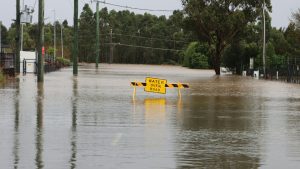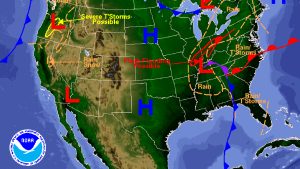What Is a Weather Front?
A weather front is a boundary where two different air masses meet—typically one warmer and one colder. These air masses don’t mix easily, so their clash creates dynamic weather patterns. Understanding fronts helps explain why the weather can change quickly.
The Four Main Types of Weather Fronts
1. Cold Front
- Description: A cold air mass moves into a warmer region, pushing the warm air up quickly.
- Weather Effects: Sudden temperature drops, gusty winds, and potentially severe storms or heavy rain. Often followed by clearer, cooler skies.
- Clouds Involved: Cumulonimbus or towering cumulus clouds.
2. Warm Front
- Description: A warm air mass slides over a retreating cold air mass.
- Weather Effects: Gradual increase in temperature, steady rain or drizzle, followed by warm, humid air.
- Clouds Involved: Cirrus → Altostratus → Nimbostratus, forming a layered sky as the front approaches.
3. Stationary Front
- Description: Neither air mass is strong enough to move the other. The front stalls in place.
- Weather Effects: Extended periods of cloudiness and rain, sometimes lasting days in one region.
- Clouds Involved: Nimbostratus and stratus clouds.
4. Occluded Front
- Description: A faster-moving cold front overtakes a slower warm front.
- Weather Effects: Complex systems that often bring heavy precipitation, followed by clearing skies.
- Clouds Involved: A combination — often cumulonimbus and stratiform layers.
How to Identify Fronts on Weather Maps
- Cold Front: A blue line with triangles pointing in the direction of movement.
- Warm Front: A red line with semicircles pointing forward.
- Stationary Front: A mix of red semicircles and blue triangles on opposite sides of the line.
- Occluded Front: A purple line with alternating triangles and semicircles pointing in the same direction.
Why Weather Fronts Matter
Fronts mark zones of rapid weather change. For storm chasers, meteorologists, and even weekend travelers, understanding how and where fronts form is critical for:
- Predicting thunderstorms or snow
- Understanding regional temperature swings
- Planning outdoor activities or safety measures
Conclusion
Weather fronts are the battle lines between warm and cold air masses. Recognizing their signs and understanding their behavior unlocks a deeper understanding of weather dynamics—and why your local forecast can shift so quickly.




